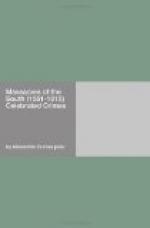The first of these was a woman from Vivarais, whose origin was unknown. She went about from town to town, shedding tears of blood. M. de Baville, intendant of Languedoc, had her arrested and brought to Montpellier. There she was condemned to death and burnt at the stake, her tears of blood being dried by fire.
After her came a second fanatic, for so these popular prophets were called. He was born at Mazillon, his name was Laquoite, and he was twenty years of age. The gift of prophecy had come to him in a strange manner. This is the story told about him:—“One day, returning from Languedoc, where he had been engaged in the cultivation of silkworms, on reaching the bottom of the hill of St. Jean he found a man lying on the ground trembling in every limb. Moved by pity, he stopped and asked what ailed him. The man replied, ’Throw yourself on your knees, my son, and trouble not yourself about me, but learn how to attain salvation and save your brethren. This can only be done by the communion of the Holy Ghost, who is in me, and whom by the grace of God I can bestow on you. Approach and receive this gift in a kiss.’ At these words the unknown kissed the young man on the mouth, pressed his hand and disappeared, leaving the other trembling in his turn; for the spirit of God was in him, and being inspired he spread the word abroad.”
A third fanatic, a prophetess, raved about the parishes of St. Andeol de Clerguemont and St. Frazal de Vantalon, but she addressed herself principally to recent converts, to whom she preached concerning the Eucharist that in swallowing the consecrated wafer they had swallowed a poison as venomous as the head of the basilisk, that they had bent the knee to Baal, and that no penitence on their part could be great enough to save them. These doctrines inspired such profound terror that the Rev. Father Louvreloeil himself tells us that Satan by his efforts succeeded in nearly emptying the churches, and that at the following Easter celebrations there were only half as many communicants as the preceding year.
Such a state of licence, which threatened to spread farther and farther, awoke the religious solicitude of Messire Francois Langlade de Duchayla, Prior of Laval, Inspector of Missions of Gevaudan, and Arch-priest of the Cevennes. He therefore resolved to leave his residence at Mende and to visit the parishes in which heresy had taken the strongest hold, in order to oppose it by every mean’s which God and the king had put in his power.
The Abbe Duchayla was a younger son of the noble house of Langlade, and by the circumstances of his birth, in spite of his soldierly instincts, had been obliged to leave epaulet and sword to his elder brother, and himself assume cassock and stole. On leaving the seminary, he espoused the cause of the Church militant with all the ardour of his temperament. Perils to encounter; foes to fight, a religion to force on others, were necessities to this fiery character, and as everything at the moment was quiet in France, he had embarked for India with the fervent resolution of a martyr.




